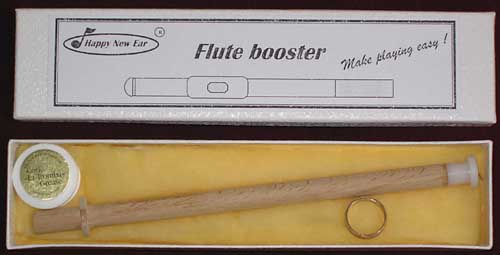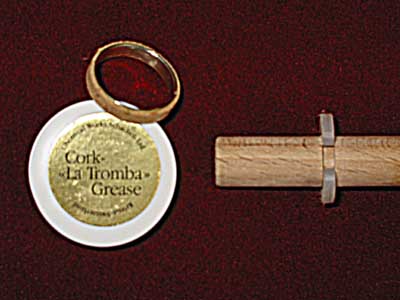![]()
![]()

In theory, putting a disturbance in the airflow behind the riser will cause increased pressure between the disturbance and the air source. Since we have muscles and nerves controlling the air source, an increase in pressure within the head joint should be felt as increased resistance in the flow from/at the air source.
Several flutists have stated that current trends in beginner flutes to provide "easy blowing" or "free flowing" head joint cuts actually make it more difficult for students to control intonation, dynamics, and they decrease tone color breadth.
In control theory, as well, servo systems exhibit smoother response to perturbations when a small amount of feedback is available to the controller. Thus an increase in resistance from a flute ring could translate to improved sound.
A google search only brings up four hits for "Olnhausen Flute Ring". Two hits are flutists that use the ring, one site is the Larry Krantz hosted information page, and one is a poll that shows less than five out of 240 folks are using the ring.
The seller - Brooks de Wetter-Smith was very nice in both email correspondences I received from him, and the ring kit arrived promptly. He has a page for the ring at: Olnhausen Site
With this theoretical support and the strength of the claims for the Olnhausen flute ring, I sent off the US$85 to get my new-flute alternative.

The ring is thin silver lined with compressible cork to fit snuggly in the head joint. With a little cork grease applied, the ring is placed on the wood insertion tool and pushed up till the end of the dowel bisects the blow hole. It fits snug enough not to move when cleaning the head joint with a silk or flute flag.
I should add, at this point, that I am an adult beginner flute player. In attempting to map the intonation of my flute before the ring, I have produced graphical proof of my immature embouchure.
The plan for objectivity in this investigation: record the same notes with and without the ring on my Tascam PocketStudio 5 digital recorder with the strict registration of the MIDI tone generator playing the bass line of Corelli's Sarabanda, then play a two octave C major scale, followed by Filas: Top register Study #2 to see if third register slurs and tone are improved.
By laying down one track before the ring and the same song with the ring aligned to the exact same MIDI track, I can switch back and forth rapidly to determine what, if any, differences can be heard.
My first impression with the ring came as I warmed up on a first register C scale. The tone seemed a little warmer, perhaps just a little airy, not particularly better to my ears. Complex is nice, but I prefer a pure tone first register with a little bit of a growl on the lowest notes. Where I had hoped to hear a more pure tone, with sharper edges to a purer tone, like turning my piercing Armstrong tone into a dark Altus tone... I heard air and less edges.
Moving on to playing the Sarabanda, with the ring in, did not convince me that the ring had changed me into James Galway as the brochure seemed to imply would happen. As I finished that and recorded the scale and the top register study, it was pretty clear there is a difference in tone with the ring, but it is quite subtle.
Could I feel a difference in slurs or articulation or resistance or dynamics?
Well....no.
Quickly jumping mid-note between the tracks with and without the ring was interesting. There is a very, very, very slight audible difference, but perhaps after playing without the ring for so many years I prefer the sound I am used to. It seems like the "with ring" tone is more "complex"....lacking edge.
One very big difference did show up. I had to pull my head joint out an additional 3/8->1/2 inch to match the overblown E2 to B2 (also the point where A=442 on my flute). A quick glance at the tuner, still showed me playing flat in much of the bottom register, but I didn't map the flute and compare all the notes with and without. My tone is probably not actually consistent enough to measure a difference anyway. I wonder, though, if pulling the headjoint out so much will throw the flute way off the compromises the manufacturer chose for the scale.
I'm going to do some more recordings with and without the ring and eventually put some blurbs up here. For now...I'm just playing.
UPDATE 2005:
While my Jupiter 711 is in for COA, I have been playing the Armstrong 80B for a month. I decided to try one of my ABRSM Grade 3 works - Popp #24 from "63 Melodic Studies", Simon Hunt, without the Olnhausen ring to see if the high E was any easier to hit reliably. Big mistake, E became less reliable, not more so. The ring went back in and will stay in.
![]()
© 2005 Alan McDonley. All rights reserved.